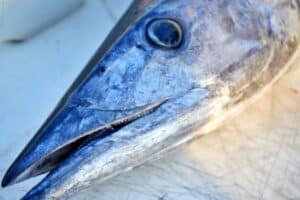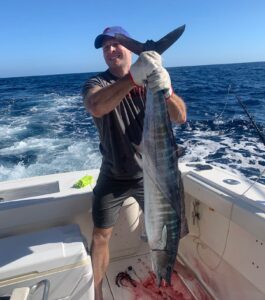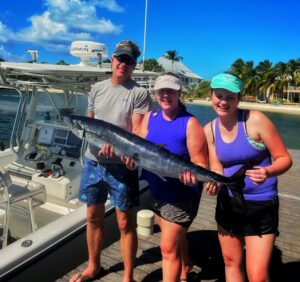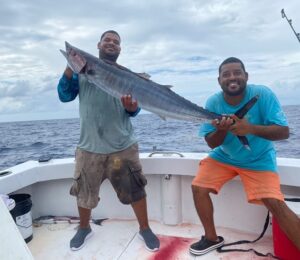Wahoo is a prized catch in the Cayman Islands (and other places). These super-fast swimmers (up to 50 mph or 78 km/h) are known for hard strikes, quick hard runs, razor-sharp teeth, and delicious flesh.

Wahoo (Acanthocybium solandri) is found worldwide in tropical and subtropical seas. Wahoo, tuna, mackerel, and bonito are the family Scombridae. In Hawaii, wahoo is called Ono.
Scientists consider wahoo populations stable, and the species is not endangered. They are highly productive and widely distributed throughout the tropical/subtropical Atlantic, Pacific, and Indian oceans. Worldwide there is little commercial fishing of wahoo. One reason is that they do not typically gather in large schools making large-scale fishing less productive. That’s good news for sports fishermen as they can count on the species being plentiful for years to come.

The Atlantic Wahoo is long and slender with elongated jaws that form a snout half the length of their heads. These truly majestic fish are steel blue on top and silvery blue below. They are covered with tiny scales and a series of beautiful black-blue vertical stripes. These stripes are most prominent when just out of the water and fade quickly after death.
Wahoo, alternatively known as Acanthocybium solandri, captures attention as a remarkable predator of the deep blue sea. It boasts distinct characteristics that set it apart, including two dorsal fins, with the first being notably longer than the second. Following these, you’ll find 8-9 finlets on either side. The anal fin, also accompanied by 8-9 finlets, is positioned below the second dorsal fin. The pelvic fins are below the pectoral fins, and the caudal peduncle, equipped with three sets of keels, lies just in front of the caudal fin.
A Wahoo’s mouth contains approximately 100-120 razor-sharp, serrated teeth, tightly compressed in a single row on both the upper and lower jaw. This ferocious predator possesses jaws that snap open and close rapidly, much like a pair of scissors, delivering powerful, swift bites. In contrast to barracudas, whose jagged teeth leave behind tears and chunks, a wahoo’s bite creates clean and precise wounds.
Anglers must exercise caution when they handle wahoos on deck, as the fish is known to thrash and rapidly open and close its mouth. Countless fishing trips have ended prematurely when anglers have sought medical attention due to wounds inflicted by a wahoo.
In the world of deep-sea fishing, wahoos undoubtedly present an exciting challenge, and their unique features make them a fascinating catch.

Wahoo, although it may live longer, typically boasts an average lifespan of 5 to 6 years. They achieve sexual maturity in their first year, with males measuring around 32″ and females slightly larger at 40″. During the spawning season, females spawn multiple times, releasing millions of eggs to ensure the species’ survival. These remarkable fish can grow up to 8 feet in length and weigh up to 150 pounds. While it’s common to find wahoo in the 40″-60″ range in Cayman waters, the record-breaking catch was Elvet Conolly’s 146 lbs 2 oz monster in 2007.

What about behavior, wahoo are highly predatory and attack their prey with great enthusiasm. They often roam alone or in small groups, occasionally leading to multiple hook-ups. Anglers can sense a wahoo on the line when they experience a swift run following a powerful strike. Their diet consists of various fish species, such as blackfin tuna, flying fish, squid, and baitfish, sometimes competing with tuna for the same prey. Wahoo’s sharp teeth and robust jaws allow them to feed on larger prey, while smaller wahoo become targets for other predators sharing their habitat.
Summary, Wahoo Fishing in Grand Cayman is not just an adventure; it’s an unforgettable journey filled with excitement, camaraderie, and the promise of delicious feasts. With the perfect blend of thrill and flavor, it’s no wonder that wahoo fishing in Grand Cayman is a must-try experience for anyone visiting this beautiful island.